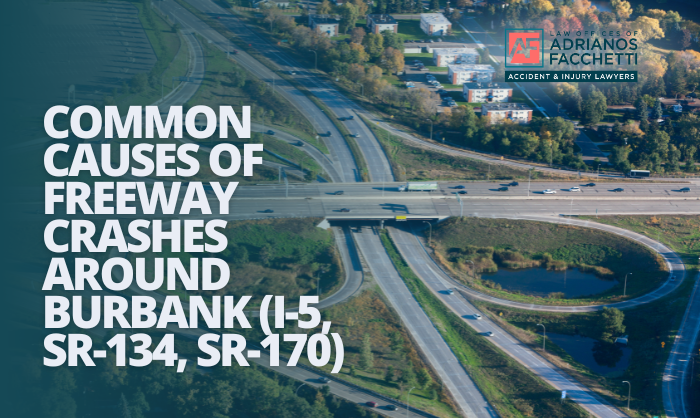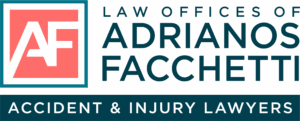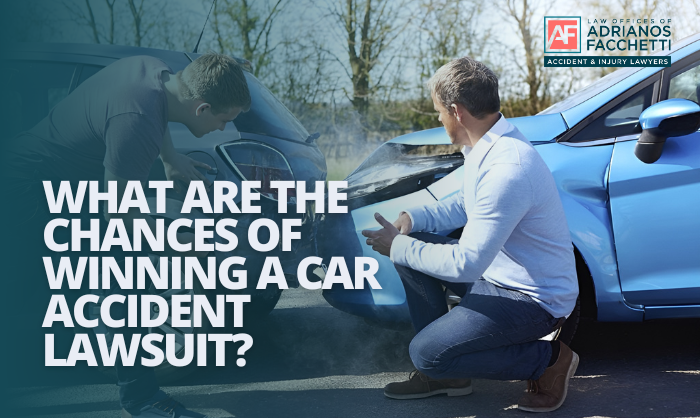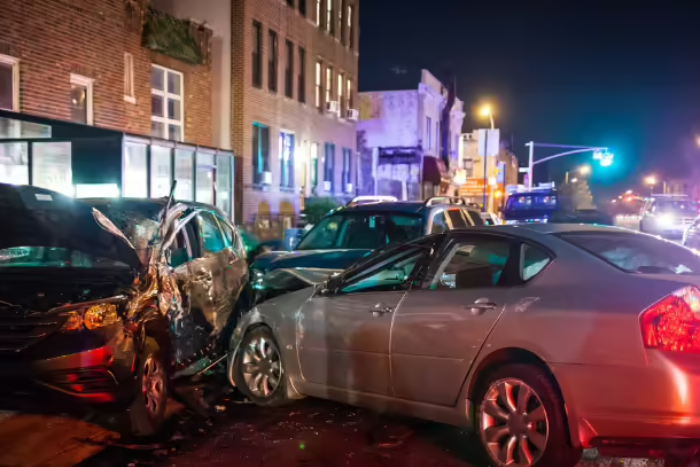Have you ever hit the I‑5 or SR‑134 during peak traffic and felt like everyone’s racing to make the next lane change or exit? Around Burbank, it’s not just frustrating , it’s risky. With fast-moving lanes, short merge zones, and trucks mixed into commuter flow, crashes happen more often than most drivers expect.

If you’ve been involved in a freeway accident or just want to understand what makes these roads so dangerous, this breakdown of the most common causes can help. And if you're looking for answers after a crash, a Burbank Car Accident Lawyer can guide you through your next steps.
Why Burbank Freeways See So Many Serious Crashes
Freeways like I‑5, SR‑134, and SR‑170 aren't just busy, they're complicated. Each route carries different types of traffic, from commuters to airport travelers to freight trucks, all converging in a tight space.
The freeway layout around Burbank doesn’t leave much room for error. Ramps are close together, lanes are packed, and traffic often goes from fast to stopped in seconds. That kind of unpredictability leads to more crashes.
Even experienced drivers can get caught off guard. A moment of hesitation during a lane change or an unexpected slowdown in a merge zone can trigger a multi-car collision.
Knowing how these freeways operate and where the risks are concentrated can help explain how and why many of these crashes happen and how they could have been avoided.
Driver-Behavior Causes (The Biggest Crash Trigger)
Most freeway crashes aren't just about bad luck, they often start with small mistakes in judgment or attention. In the Burbank area, with its tight lanes and constant flow, those mistakes can turn serious fast.
When someone drives distracted, speeds up to beat traffic, or weaves between lanes, it raises the risk for everyone nearby. These behaviors are especially dangerous near on-ramps and exits where space is limited.
Even sober drivers can make unsafe moves if they're tired, in a hurry, or misjudge what’s happening around a large truck. On freeways, those choices can have serious consequences.
Understanding how human behavior plays into crash risk helps build a clearer case and shows how certain factors could shift liability in a collision.
Distracted Driving on Busy Interchanges
Distractions don’t have to last long to cause trouble. A quick glance at a phone or adjusting GPS can lead to a missed brake light or late lane change.
On SR‑134 and SR‑170, merge lanes are short and decisions have to be made fast. A distracted driver might not notice traffic slowing or a vehicle already in their blind spot.
In many local crashes, phone use or inattention shows up as a factor and it's often hard to prove unless caught on camera or through witness accounts. That’s why it’s important to act quickly after a crash.
Unsafe Speed and Speeding in Flow-Then-Stop Traffic
Speeding doesn't just mean breaking the speed limit. It also includes driving too fast for the conditions, like when traffic ahead is about to come to a stop.
On I‑5 near Burbank, that’s common, drivers cruise at 65+ mph, then hit traffic that’s suddenly crawling. The result is often a chain reaction of rear-end crashes.
It’s easy to overlook speed as a cause if traffic was moving well just moments earlier. But the timing and flow matter, especially when insurance adjusters or lawyers are reviewing what happened.
Aggressive Driving and Lane Weaving
Not everyone stays patient in traffic. Some drivers tailgate, swerve through gaps, or cut across multiple lanes to make an exit at the last second.
In Burbank, congestion brings out that kind of behavior more often—especially during peak hours. Drivers who push through traffic like this can put others in danger without realizing it.
Aggressive moves usually happen quickly, but the consequences last. These types of crashes tend to be hard to avoid for anyone nearby who’s driving safely.
Impaired Driving (Alcohol, Cannabis, or Other Drugs)
Driving under the influence isn't always obvious at first, but it has serious effects on how someone reacts and makes decisions. That’s dangerous anywhere, but especially on fast, crowded freeways.
At night and on weekends, the risk is higher. Events in the area or late returns from work can leave impaired drivers sharing the road with regular commuters.
Proving impairment matters in a legal case. It often explains erratic behavior like sudden lane departures or delayed braking, actions that may have led to the crash.
Fatigue and Drowsy Driving
Long drives, early mornings, and late nights all take a toll. Fatigue doesn’t look dramatic, but it slows reaction time and causes small errors that add up fast.
Drivers on SR‑134 or SR‑170 often commute long distances. A moment of zoning out or missing traffic flow can lead to a crash, especially in areas where traffic shifts quickly.
When drowsy driving plays a role, it can be tough to spot unless witnesses or patterns help confirm it. Still, it remains a common thread in many freeway collisions.
Merge and Exit Miscalculations (Especially Around Trucks)
Merging looks simple, but on a packed freeway, it takes precise timing. Misjudging another car’s speed or trying to squeeze in last-minute can lead to impact.
Trucks add another layer. They need more room to brake and can’t shift lanes as quickly. Drivers who cut in too closely near a truck’s front bumper or blind spot risk a serious collision.
These kinds of misjudgments often happen near exits or at points where traffic is heavy. After a crash, showing how one driver’s decision caused a chain reaction becomes key in building the case.
Heavy Commercial Truck Volume
Trucks don’t drive like smaller vehicles, and on a freeway like I‑5, they’re hard to avoid. They take longer to stop, need more room to turn, and often can’t see cars that are too close.
During busy hours, that can be a dangerous mix. Merging in front of a truck or getting caught beside one during a lane shift can easily lead to a crash.
Many drivers don’t realize just how limited a truck driver’s visibility is. After an accident, that detail matters in figuring out how the crash happened and who was responsible.
Understanding how trucks move and how much space they need, helps explain the cause of many crashes on freight-heavy routes like I‑5.
Construction Zones, Lane Closures, and Detours
Construction zones change the flow of traffic without much warning. Lanes narrow, signs shift, and merge points get moved around with very little time to react.
Drivers who aren’t paying close attention or are moving too fast through these areas can easily miss a cue or clip another car.
Even well-marked work zones can feel confusing, especially during dark hours or in unfamiliar areas. These conditions raise crash risk for everyone on the road.
When a crash happens in or near a construction zone, getting the details right, like how the lanes were set up or if signs were visible becomes key in any legal review.
Road Design and Visibility Challenges
Some interchanges around Burbank weren’t built for the traffic they see today. Tight turns, odd lane angles, and overlapping exits make it hard to move through safely, especially when traffic is heavy.
Visibility adds to the challenge. Poor lighting, glare from other vehicles, or worn-out lane stripes make it harder to see where the car should be.
Even familiar roads can feel confusing when lighting is bad or the layout shifts at the last second. These conditions often contribute to sideswipes, missed exits, or sudden braking.
Accidents in these spots often raise questions about how road design or visibility may have contributed to what happened.
Weather, Road Debris, and Breakdowns
Weather in Southern California may be mild, but when it shifts, roads change fast. The first light rain can make the pavement slick and unpredictable.
Fog, bright morning glare, and debris on the road can reduce reaction time. When visibility is cut, even cautious drivers may struggle to respond quickly.
Breakdowns in the middle of traffic or objects left in a lane force drivers to make sudden moves, which often leads to secondary crashes.
In cases like these, documenting the exact road conditions is important. It helps show how the environment factored into the chain of events.
Talk With a Burbank Freeway Crash Lawyer
Knowing what caused a freeway crash is only the first step. When injuries are involved, getting help early can protect the chance to recover damages.
A Burbank Car Accident Lawyer understands how local freeways operate and what evidence matters most. Acting quickly helps preserve camera footage, identify nearby witnesses, and gather reports before they’re lost.
Truck-related crashes may involve special data from onboard systems. A lawyer can request that data before it gets erased or locked behind corporate red tape.
If the crash led to injuries, having strong documentation matters. Medical records, scene photos, and witness details all play a role in building the case.
For a free consultation at any time, call (626) 793-8607. Legal help is available 24/7 for Burbank freeway crashes involving I‑5, SR‑134, and SR‑170.














